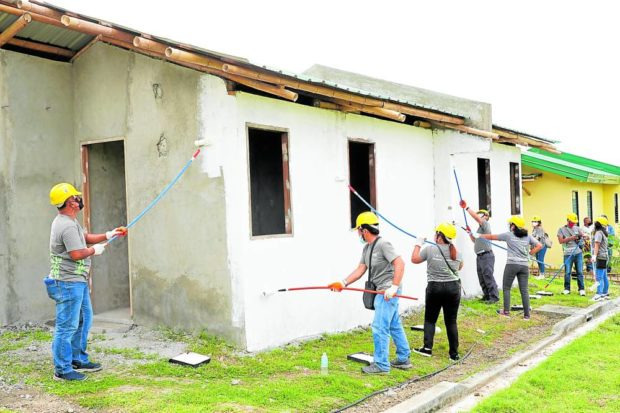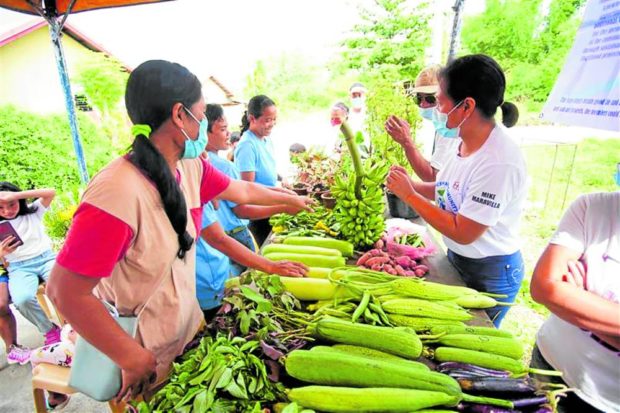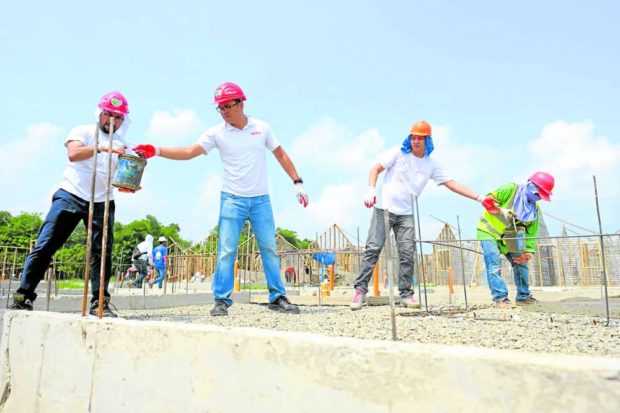Housing the poor in Negros Occidental

RESTARTING LIVES | Habitat for Humanity and its partner, Hilti Foundation, are building 10,000 housing units for urban poor families in Negros Occidental province, with homes in a community in Barangay E. Lopez, Silay City, already completed, and those in San Carlos City currently under construction. The project aims to help beneficiaries restart their lives by providing them with disaster-resilient shelters in a safe and peaceful environment. —CONTRIBUTED PHOTO
SILAY CITY, Negros Occidental, Philippines — While taking occasional sips from her early morning cup of coffee in front of her “bamboo house,” Raquel Bayona, 49, recalled her family’s previous dwelling in Barangay Guinhalaran.
They used to live in a shanty made of light materials that was built along the coastline, giving Bayona and her family of 11 constant fear, especially during typhoons and heavy rains. But four years ago, just as the family was about to be evicted, Bayona was chosen to be among the 86 families who would receive their own houses at Bonbon Resettlement Project in Barangay E. Lopez here.
Now, the resettlement has become more than just a housing project as it has grown into a community, now called “Katuwang,” which means partners in the vernacular.
The houses have provided beneficiaries a sense of security and peace because not only that these can withstand storms but the community is also peaceful and cleaner. There is no fear of being evicted because they are now proud owners of a house and the lot on which it stands.
Bayona said that when they were in Sitio Golf, they felt vulnerable because they could just be driven away anytime being illegal settlers.
Article continues after this advertisement
BACKYARD PRODUCTS | Vegetables, ornamental plants and food products produced by residents of a resettlement project, now called Katuwang, in Silay City are showcased in a mini market fair during the visit of Habitat for Humanity International president Jonathan Reckford on July 10. —CONTRIBUTED PHOTO
Disaster-resilient
They were also afraid that the house would be blown away during typhoons since it was made of only GI sheets, wood scraps, and tarpaulin sheets and was along Silay’s coastline.
Article continues after this advertisementIn May 2018, their worst fear happened.
The owners of the property had told them and their neighbors to leave because they would use the land.
While on the verge of being homeless, Bayona’s family was identified as one of the poorest of the poor who would benefit from the housing project called Negros Occidental Impact 2025 (NOI25).
NOI25 is implemented in partnership with Habitat for Humanity and Hilti Foundation to address the housing gap in Negros Occidental. Houses built for the project use a combination of bamboo and concrete, making the structures disaster-resilient.
Developed by BASE Bahay Foundation, a Habitat for Humanity partner, the “cement-bamboo frame” technology utilizes treated bamboo as structural frames for houses in lieu of the conventional and costly steel. Bamboo frames have been found to be resilient, sustainable, and cost-efficient, according to its developers.
The target was to build 10,000 housing units in communities deemed secure and safe and away from disaster zones.
Habitat for Humanity selected Negros Occidental as a project site because the province has over 166,000 informal settlers, it is disaster-prone and raw materials, like bamboo, are widely available. Another factor was the full support that local officials had committed to the project.

VOLUNTEER WORK At least 200 volunteers helped build homes for 86 poor families in Silay City in 2018. Today, the project has become a vibrant community where its members are engaged in livelihood activities. —CONTRIBUTED PHOTO
Sense of community
Katuwang in Bonbon began to take shape in October 2018 on a government-owned lot at Barangay E. Lopez, about 16 kilometers from the city proper of Silay.
With the help of its army of volunteers and several donors, Habitat for Humanity was able to build a community for 86 families where the bamboo homes have provided warmth, comfort, and space for growth.
For Jennifer Aspero, who was once an informal settler at Hacienda Normandiya, Barangay Bagtik, Katuwang was a “blessing.”
Without it, she said, her family would have been rendered homeless since their land had long been converted into sugarcane fields.
While Katuwang is far from the city proper, Gina Emprogo, Bayona’s sister who also used to live at Sitio Golf, said they are happy where they are now.
Aside from a safe neighborhood, Emprogo said the families had been provided livelihood assistance so they could eventually stand on their own.
The husbands of Emprogo and Bayona are construction workers, whose employment depends on vacancies at work sites. Livelihood
To help provide residents additional income, Katuwang community members tend to their own vegetable garden. The beneficiaries also maintain peace and order, and sanitation in the community.
According to Lala Baldelovar, Habitat for Humanity Philippines chief development officer, the Silay City government allowed the residents to use the adjacent vacant lot to grow their own vegetables and fruits. The families’ harvest are sold in the local market, she said.
On July 10, a delegation from Habitat for Humanity and Hilti Foundation, led by Jonathan Reckford, Habitat for Humanity International chief executive officer, visited the Katuwang community to check on the beneficiaries.
And they were happy with what they saw.
“They have confirmed that families can improve their lives through safe and decent homes,” said Baldelovar.
The families, she added, have started improving their houses by adding a room or expanding the kitchen. Some went into home-based livelihood activities such as food catering, sari-sari (variety) store, and producing products like soap, food, and macrame (fiber art).
The beneficiaries expressed their gratitude to the many organizations, people and donors who helped the community through the years.
In front of the delegates, Patricia Arsenal said her family’s life changed when they were given a house at Katuwang.
Other project sites
“Now, we can sleep peacefully, no more stress from heavy rains … As we live in this place, we are delighted and contented [with] the life we have,” said Arsenal, who, like Bayona, once lived in an urban poor area.
Habitat for Humanity is also eyeing other areas in Negros Occidental as sites for future projects.
On July 11, the organization, with its partners and volunteers, went to San Carlos City to build 60 houses as part of the 230-housing unit community that would benefit employees of the foreclosed San Carlos Milling Company Inc.
“Depending on when the DHSUD (Department of Human Settlement and Urban Development) accreditation will be received, the project can be completed in 18 months,” said Baldelovar.
Other projects lined up in Negros Occidental included 230 units in La Carlota City, 196 in San Carlos City, 212 in Silay City and 387 in Bacolod City.
According to the Philippines Statistics Authority, approximately 4.5 million Filipinos were homeless as of 2020.
A large proportion of them consisted of Filipinos who slept on the streets, under bridges, and in other cramped places unfit for safe and comfortable living.
This gap in Filipinos’ living conditions is being narrowed by Habitat for Humanity through the NOI25 project, one house at a time, leaving behind stories of hope where bamboo houses are built.
RELATED STORIES
DHSUD rolls out more housing projects for IPs
Jose Acuzar takes oath as housing chief under Bongbong Marcos admin